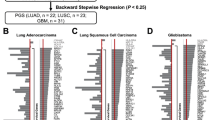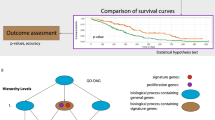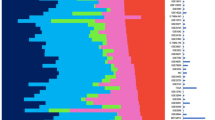Abstract
The development of an oncogenic state is a complex process involving the accumulation of multiple independent mutations that lead to deregulation of cell signalling pathways central to the control of cell growth and cell fate1,2,3. The ability to define cancer subtypes, recurrence of disease and response to specific therapies using DNA microarray-based gene expression signatures has been demonstrated in multiple studies4. Various studies have also demonstrated the potential for using gene expression profiles for the analysis of oncogenic pathways5,6,7,8,9,10,11. Here we show that gene expression signatures can be identified that reflect the activation status of several oncogenic pathways. When evaluated in several large collections of human cancers, these gene expression signatures identify patterns of pathway deregulation in tumours and clinically relevant associations with disease outcomes. Combining signature-based predictions across several pathways identifies coordinated patterns of pathway deregulation that distinguish between specific cancers and tumour subtypes. Clustering tumours based on pathway signatures further defines prognosis in respective patient subsets, demonstrating that patterns of oncogenic pathway deregulation underlie the development of the oncogenic phenotype and reflect the biology and outcome of specific cancers. Predictions of pathway deregulation in cancer cell lines are also shown to predict the sensitivity to therapeutic agents that target components of the pathway. Linking pathway deregulation with sensitivity to therapeutics that target components of the pathway provides an opportunity to make use of these oncogenic pathway signatures to guide the use of targeted therapeutics.
This is a preview of subscription content, access via your institution
Access options
Subscribe to this journal
Receive 51 print issues and online access
$199.00 per year
only $3.90 per issue
Buy this article
- Purchase on SpringerLink
- Instant access to full article PDF
Prices may be subject to local taxes which are calculated during checkout




Similar content being viewed by others
References
Fearon, E. R. & Vogelstein, B. A genetic model for colorectal tumorigenesis. Cell 17, 671–674 (1990)
Hanahan, D. & Weinberg, R. A. The hallmarks of cancer. Cell 100, 57–70 (2000)
Sherr, C. J. Cancer cell cycles. Science 274, 1672–1677 (1996)
Ramaswamy, S. & Golub, T. R. DNA microarrays in clinical oncology. J. Clin. Oncol. 20, 1932–1941 (2002)
Lamb, J. et al. A mechanism of cyclin D1 action encoded in the patterns of gene expression in human cancer. Cell 114, 323–334 (2003)
Huang, E. et al. Gene expression phenotypic models that predict the activity of oncogenic pathways. Nature Genet. 34, 226–230 (2003)
Black, E. P. et al. Distinct gene expression phenotypes of cells lacking Rb and Rb family members. Cancer Res. 63, 3716–3723 (2003)
Segal, E., Friedman, N., Koller, D. & Regev, A. A module map showing conditional activity of expression modules in cancer. Nature Genet. 36, 1090–1098 (2004)
Rhodes, D. R. et al. Large-scale meta-analysis of cancer microarray data identifies common transcriptional profiles of neoplastic transformation and progression. Proc. Natl Acad. Sci. USA 101, 9309–9314 (2004)
Ramaswamy, S., Ross, K. N., Lander, E. S. & Golub, T. R. A molecular signature of metastasis in primary solid tumors. Nature Genet. 33, 49–54 (2003)
Mootha, V. K. et al. PGC-1α-responsive genes involved in oxidative phosphorylation are coordinately downregulated in human diabetes. Nature Genet. 34, 267–273 (2003)
West, M. et al. Predicting the clinical status of human breast cancer by using gene expression profiles. Proc. Natl Acad. Sci. USA 98, 11462–11467 (2001)
D'Crus, C. M. et al. c-MYC induces mammary tumorigenesis by means of a preferred pathway involving spontaneous Kras2 mutations. Nature Med. 7, 235–239 (2001)
Sweet-Cordero, A. et al. An oncogenic KRAS2 expression signature identified by cross-species gene expression analysis. Nature Genet. 37, 48–54 (2005)
Rodenhuis, S. et al. Mutational activation of the K-ras oncogene and the effect of chemotherapy in advanced adenocarcinoma of the lung: a prospective study. J. Clin. Oncol. 15, 285–291 (1997)
Salgia, R. & Skarin, A. T. Molecular abnormalitities in lung cancer. J. Clin. Oncol. 16, 1207–1217 (1998)
Cory, A. H. Use of an aqueous soluble tetrazolium/formazan assay for cell growth assays in culture. Cancer Commun. 3, 207–212 (1991)
Riss, T. L. & Moravec, R. A. Comparison of MTT, Xtt, and a novel tetrazolium compound for MTS for in vitro proliferation and chemosensitivity assays. Mol. Biol. Cell 3, 184a (1992)
Stampfer, M. R. & Yaswen, P. Culture systems for study of human mammary epithelial cell proliferation, differentiation, and transformation. Cancer Surv. 18, 7–34 (1993)
Huang, E. et al. Gene expression predictors of breast cancer outcomes. Lancet 361, 1590–1596 (2003)
Irizarry, R. A. et al. Exploration, normalization, and summaries of high density oligonucleotide array probe level data. Biostatistics (in the press)
Bolstad, B. M., Irizarry, R. A., Astrand, M. & Speed, T. P. A comparison of normalizaton methods for high density oligonucleotide array data based on variance and bias. Bioinformatics 19, 185–193 (2003)
Eisen, M. B., Spellman, P. T., Brown, P. O. & Botstein, D. Cluster analysis and display of genome-wide expression patterns. Proc. Natl Acad. Sci. 95, 14863–14868 (1998)
Mitsudomi, T. et al. Mutations of ras genes distinguish a subset of non-small-cell lung cancer cell lines from small-cell lung cancer cell lines. Oncogene 6, 1353–1362 (1991)
Acknowledgements
We are grateful to P. Bild for the inspiration to pursue this research. We also thank K. Shianna, J. Freedman, S. Mori, L. Jakoi and K. Culler for their assistance. A.H.B. has been supported by an AACR-Anna D. Barker Fellowship and an ACS Postdoctoral Fellowship. This work was supported by grants from the NIH (to J.R.N.). Author Contributions A.H.B. was responsible for all experimental work and computational data analysis. A.H.B. and J.R.N. were responsible for project planning and data analysis. G.Y., J.T.C. and Q.W. were responsible for generation of specialized computer programs used in these studies. H.K.D. and A.P. provided intellectual input and data management support. D.C. and M.-B.J. provided technical support for experiments. M.W. was responsible for conception of the statistical approach and intellectual input. A.B., J.M.L., J.R.M., J.A.O. and D.H. were responsible for the development of clinical resources used in the study.
Author information
Authors and Affiliations
Corresponding author
Ethics declarations
Competing interests
The GEO accession numbers for the datasets are: GSE3156, breast cancer cell lines; GSE3158, mouse tumour data set; GSE3151, oncogene signature data set; GSE3141, lung cancer data set; GSE3143, breast cancer data set; GSE3149, ovarian cancer data set. Reprints and permissions information is available at npg.nature.com/reprintsandpermissions. The authors declare no competing financial interests.
Supplementary information
Supplementary Table 1
Genes that predict pathway deregulation. (PDF 89 kb)
Supplementary Table 2
Ras mutation status in NSCLC samples. (PDF 39 kb)
Supplementary Table 3
Characteristics of breast cancer cell lines. (PDF 53 kb)
Supplementary Figure 1
Biochemical assays of pathway activation. (PDF 190 kb)
Supplementary Figure 2
Gene expression patterns that predict oncogenic pathway deregulation. (PDF 506 kb)
Supplementary Figure 3
Validation of pathway predictions in tumors. (PDF 300 kb)
Supplementary Figure 4
Kaplan-Meier survival analysis for cancer patients based on individual pathway predictions for the tumor dataset. (PDF 2243 kb)
Supplementary Figure 5
Assays for pathway activities in breast cancer cell lines. (PDF 206 kb)
Supplementary Figure 6
Relationship of drug sensitivity to predictions of untargeted pathways. (PDF 551 kb)
Supplementary Methods
This file contains a more detailed materials and methods description. (DOC 38 kb)
Supplementary Legends
Legends to accompany the above Supplementary Figures and Supplementary Tables. (DOC 28 kb)
Rights and permissions
About this article
Cite this article
Bild, A., Yao, G., Chang, J. et al. Oncogenic pathway signatures in human cancers as a guide to targeted therapies. Nature 439, 353–357 (2006). https://doi.org/10.1038/nature04296
Received:
Accepted:
Published:
Issue Date:
DOI: https://doi.org/10.1038/nature04296
This article is cited by
-
Sodium orthovanadate exhibits anti-angiogenic, antiapoptotic and blood glucose-lowering effect on colon cancer associated with diabetes
Cancer Chemotherapy and Pharmacology (2024)
-
Methylglyoxal: a novel upstream regulator of DNA methylation
Journal of Experimental & Clinical Cancer Research (2023)
-
Investigating subtypes of lung adenocarcinoma by oxidative stress and immunotherapy related genes
Scientific Reports (2023)
-
An intrinsic purine metabolite AICAR blocks lung tumour growth by targeting oncoprotein mucin 1
British Journal of Cancer (2023)
-
Prognostic and immune correlation analysis of mitochondrial autophagy and aging-related genes in lung adenocarcinoma
Journal of Cancer Research and Clinical Oncology (2023)



